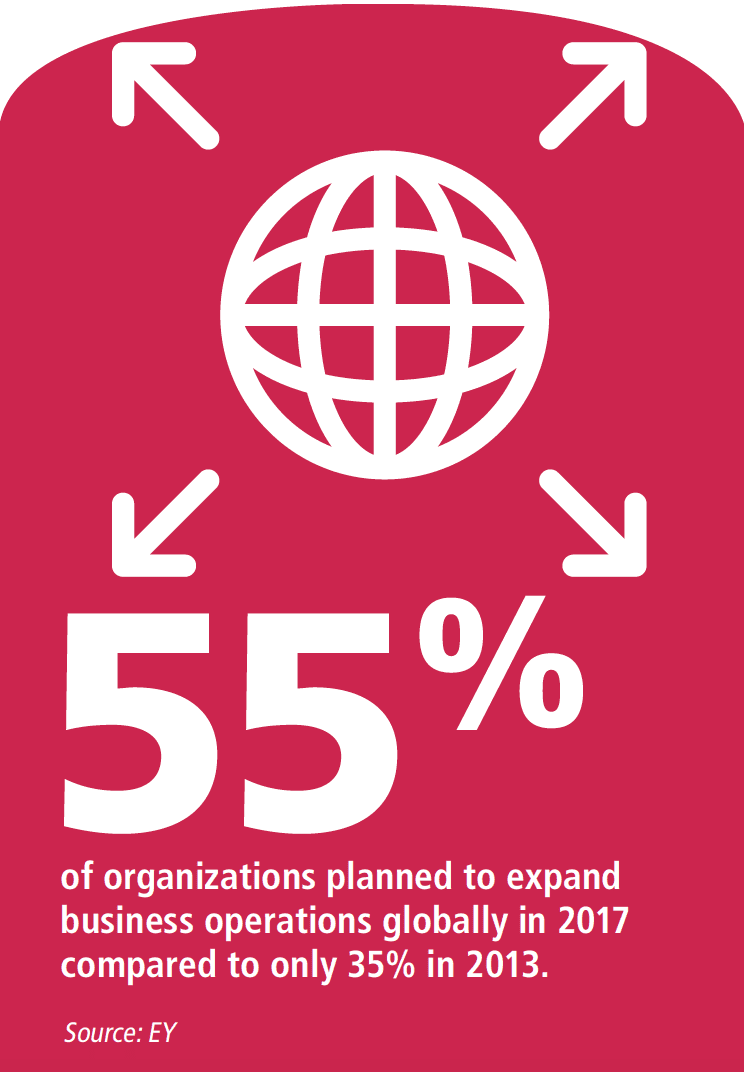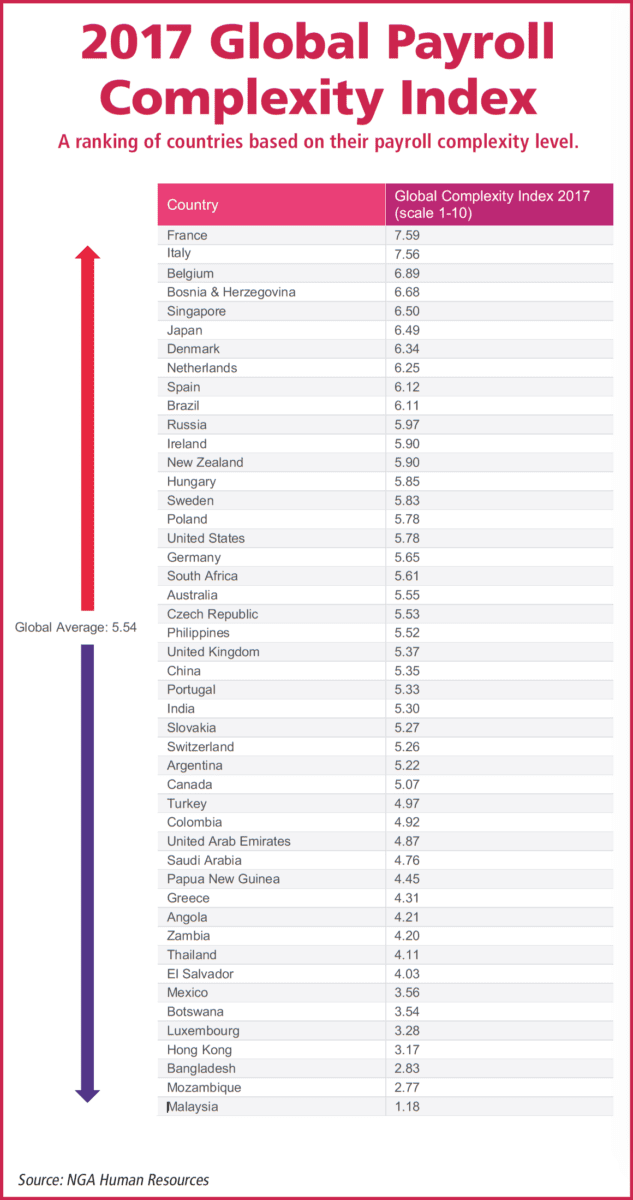Payroll complexity remains a major challenge for multinational companies expanding into new international markets.
By Marta Chmielowicz
Payroll today is about much more than just paying employees. It is about ensuring that their personal data remains secure while navigating ever-shifting legislation and privacy regulations, unstandardized solutions, changes in workforce structures, and rapidly advancing technologies. And when international operations are added into the mix, the complexity of payroll can seem even more overwhelming. In fact, according to NGA Human Resources’ 2017 Global Payroll Complexity Index, the only constant in global payroll is constant change.
The report suggests that although payroll processes are most complex in Europe, multinational companies now have to contend with myriad demands from country laws, work councils, and collective bargaining agreements throughout every aspect of their payroll process, including:
- Managing personal employee data. This includes information like employee name, address, age, pay scale, tax code, bank account number, employment contract status, and employee population type. The types of employee populations (such as blue collar, white collar, seasonal workers, and students) in a country and the characteristics of each population group both influence payroll complexity significantly.
- Overseeing payroll-related data. This includes the data necessary to calculate an employee’s net payroll amount, such as gross salary and additional benefits. Survey results show that western European countries, including Belgium, France, Italy, and Germany, have a slightly higher number of parameters needed to calculate net payroll than other geographies.
- Running payroll calculations and keeping systems updated. The 2017 report suggests that while countries now perform payroll updates less frequently than in 2014 (9.70 versus 12.33 respectively), this varies dramatically by region. Overall, Asian and African countries typically perform the fewest number of updates per year, while France and Italy each apply 20 plus annual updates to their payroll systems and processes.
- Reporting payroll data to government bodies. Depending on the country, payroll declaration procedures vary in frequency, number of data items, dependency on government data, types of required payroll reports, and more. Survey results indicate that Italy and France face the highest level of complexity related to government reporting, with Canada facing the lowest.
 While the study results show a general trend toward simplification in some of these areas from 2014 to 2017, managing multi-country payroll correctly and efficiently continues to require a detailed awareness of local payroll nuances and their associated risks. And with EY’s 2017 Global Payroll Survey suggesting that 55 percent of organizations are planning to expand business operations globally in 2017 compared to only 35 percent in 2013, organizations must learn how to contend with these complexities and adapt to each country’s specific regulations with solutions that are scalable and sustainable.
While the study results show a general trend toward simplification in some of these areas from 2014 to 2017, managing multi-country payroll correctly and efficiently continues to require a detailed awareness of local payroll nuances and their associated risks. And with EY’s 2017 Global Payroll Survey suggesting that 55 percent of organizations are planning to expand business operations globally in 2017 compared to only 35 percent in 2013, organizations must learn how to contend with these complexities and adapt to each country’s specific regulations with solutions that are scalable and sustainable.
“Developing a global payroll strategy that will direct the organization toward a solution that will fit their needs today but also scale and fit the needs for the future -and being able to execute that strategy effectively -is often the biggest challenge to successful global payroll realization,” says Pete A. Tiliakos, principal analyst of HRO at NelsonHall.
Choosing a Payroll Strategy
When developing a global payroll strategy, Tiliakos says that there is no one-size-fits-all approach. Instead, companies need to evaluate whether they should adopt a standardized global payroll process or a localized approach handled through country-specific providers. There are a number of factors that help determine the best strategy for sustained growth and compliance. These considerations include:
- Risk. “Any payroll project, particularly a global one, comes with inherent risk -planning and mitigation plans are critical to success,” Tiliakos explains. “Additionally, understanding the payroll risk profile (level of complexity) for the country being targeted will play a factor in the strategic direction taken (e.g. insource versus outsource).”
To mitigate this risk, Ashok Bildikar, chairman and managing director of Neeyamo, says that organizations must become aware of all compliance requirements in each region. Assigning a compliance officer that is responsible for monitoring and managing all compliance-related issues is key. “The compliance manager is accountable for sharing and communicating inputs gathered from consultants, auditors, legal support, and payroll providers on changes in rules among countries where they exist and among those that they plan to venture into. Further, they will advise and govern inclusion of these rules in contracts that are signed between the organization and its payroll supplier,” he explains.
- Business strategy. Selecting a payroll strategy requires a significant understanding of the short- and long-term goals of the business as well as its budget and level of commitment to international expansion. According to ADP‘s Vice President for Global Payroll Strategy for Multinational Corporations Ian Sparrow, “Determining a strategy for payroll should be based on mid- to longer-term HR and strategic goals. There is a big difference between getting first employees paid and ramping up for significant employee growth where process and tools become paramount.”
The best-fit payroll delivery solution depends heavily on the type of expansion a company would like to execute. For example, opening a new office headquarters in one country brings a different set of payroll requirements than simply placing a few temporary employees in a small satellite office. To ensure success, Tiliakos says that organizations need to place the goals of the growth initiative at the forefront of their decision-making process and align their payroll approach to best support that strategy.
The timing of the expansion is another key consideration for HR professionals looking to establish a long-term, multinational payroll strategy. A company’s timeline for expansion can vary widely from project to project, and is important in determining how to handle the approach.
- Payroll delivery model maturity. Another important element that HR professionals must evaluate as part of their payroll planning process is the current state of their organization’s payroll delivery model in conjunction with the scale of the planned expansion. For example, a company that is just opening its first representative office in a new country may find that outsourcing to a local provider that offers solutions that can integrate with those in the home country is sufficient. However, companies that already have a strong, large-scale international presence would likely choose to simply scale their existing payroll process.
“If the organization has a mature delivery model of either shared service centers globally or strategic outsourcing arrangements (or a mix of both), then plugging in to these mature models and extending them to include the country requiring service only makes sense,” says Tiliakos. “However, in the case where a long-term payroll support arrangement is needed and the existing delivery model lacks maturity (e.g. outdated or disparate systems, decentralized payroll processes, etc.) or scale to support the new country, exploring a global payroll solution with an outsourcing provider is likely the best approach.”
There are pros and cons to each of these approaches. According to Bildikar, companies that choose a localized approach eliminate the risk of cultural and linguistic barriers and non-compliance with local regulations, but they also decrease their ability to scale for further expansion. The lack of integration across global systems can negatively impact payroll reporting and visibility. “Organizations with a need to ensure global compliance across countries will face difficulties in consolidating inputs across local systems and satisfying reporting requirements,” he says.
Adopting a standardized global payroll delivery solution can simplify vendor management, improve the ease of scalability and access to data, and make the user experience more consistent and positive. “With more young and mobile assignees working in multi-locations, employees expect a common HR process and approach,” explains Sparrow. “Local solutions of course have merit for local organizations -where they work and act autonomously from other affiliate companies and share no common process, tools, or reporting. But often, clients operating in multiple countries with local independent provision still look for a more centralized reporting structure to help with overall business analytics.”
Best Practices
Once organizations determine the best payroll strategy to support their international expansion plans, the following three best practices can be implemented for optimal results:
1. Standardize earning structures. According to Neeyamo’s Bildikar, standardizing compensation structures across global locations can benefit organizations with a multi-country presence by improving the ease of expansion into a new geography. “This will further contribute to having a standard compensation model across countries with a few minor exemptions to warrant adherence to compliance norms and regulations,” he explains. “While this is a highly recommended payroll strategy, companies that find revamping their existing structure a challenge can choose to design a standard earnings structure and implement it for the countries that they expand thereafter.”
2. Embrace technology. By leveraging today’s technology, organizations can help payroll advance from a data processing function to a valuable reporting resource while supporting the standardization of the employee experience. “In our experience both in HR and in payroll, depending on the scope of the engagement, 70 percent of the activities can be standardized and fully centralized while the remaining 30 percent may need to be localized and partially centralized. Technology remains the key toward creating a centralized interface with the capability to accommodate multiple languages and time zones and support standardization and centralization,” says Bildikar.
By leveraging a platform that uses robotic process automation, EY estimates that 65 percent of HR processes, including payroll, can be automated with as much as 65 percent cost savings. By handling repetitive tasks, technology can save time that HR professionals can better spend by focusing on payroll processing and data integrity.
3. Make sure the solution is flexible. Regional variations call for flexibility. “It is important that the solution can be flexible enough to operate, can integrate cost effectively, and can bring services that support clients and are relevant to their individual country needs,” says ADP’s Sparrow. “This may include adding more HR admin/personnel type services, particularly where there is limited local company infrastructure for HR and payroll related activities and limited resources available.”
Focusing on scalability and standardization, consistency of experience, and visibility into key data points will help HR professionals conquer the compliance and regulatory challenges that accompany international payroll. For organizations aspiring to elevate their business to a global level, having a robust payroll process is fundamental.
LEARN MORE
[metaslider id=12270]















